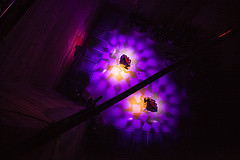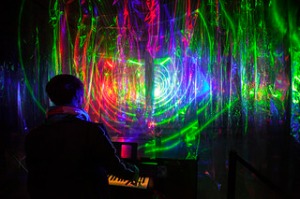August 15 & 16, 2014
MONA – Museum of Old and New Art, Hobart
Review by Josephine Giles

Bach Cello Suites
Following MONA’s inaugural Synaesthesia (2012) the Hobart museum was again closed to the general public as 400 paying guests embarked on a what curator Brian Ritchie described as “… a journey of play, exploration and private emotion”.
In contrast to the 2102 event, which sought to recreate the synaesthetic experience of associating particular colours with musical notes, Synaesthesia+ was designed to explore the broader premise of how music, text and lighting affect the senses and the brain.
Across a weekend, in two 8 hour sessions, 33 musical happenings were staged across the vast labyrinth of MONA’s galleries and surrounds.
Music, Old (primarily Bach) and New – from Schoenberg and other 20thC composers to the present day, including a World Premier orchestral piece by Matthew Hindson, and Cross Genre Experimental Improvisation – resonated in counterpoint throughout the spaces of MONA. Amongst a wish-list of international and Australian soloists performers included special guest soloist violinist Richard Tognetti, students from the National Academy of Music (ANAM), the Tasmanian Symphony Orchestra, the TSO Chorus and the best of local musicians.
Custom designed interactive lighting installations included works by multi-media artist Robin Fox, one of which was a key-board (played by in turn by audience members) that generated a 3D trippy coloured light for each note played. The overall imaginative and dramatic use of space added to the usual heightened theatrical MONA aesthetic; the synergy of elements leading to a unique experience of the physical impact of music.

Colour Organ
Up till now in Australia dance-theatre has led the way in successfully combining multi-media, music, theatre and movement; other performing art forms have been frustratingly slow to catch up. While the use of projections and film to accompany classical music is not new it has mostly been a novel addition, rather than integral component, to the concert experience. In addition, concert hall audiences are essentially trapped in a single seat for the duration of the performance and sitting on the floor, arriving late, or (god-forbid!) walking out, is considered the height of rudeness.
Just as MONA leads by example in a new way to view art in our post-post-modern multimedia age, Synaesthesia+ offered a new model of high-end music presentation. With many pieces overlapping in time or occurring simultaneously, the audience were encouraged to (politely) come and go as they pleased, and seating ranged from rows of chairs, beanbags, or none at all. Some performances led the audience through galleries and stairwells, and one’s personal impression of the music and lights could be considerably altered just by a change of vantage point.
A few attendees chose simply to wander the gallery and view the artworks, with the music as an ever-changing soundtrack; many others seemed to be sampling as much as possible of the program, staying with a piece if it grabbed them, or moving on if they were eager to see another work occurring at the same time.
A minority, myself included, preferred the other extreme of attending individual performances from beginning to end. This old-fashioned approach meant missing out on much. But I was more than amply compensated through experiencing intimate immersion in many deeply moving works, all played by world-class musicians. Some of the most powerful pieces I saw, such as Messiaen’s transcendental 135 minute long Vingt regard sur l’enfant-Jesus, played by UK-based pianist Steven Osborne, are so rarely performed I will possibly never again see them live.
I am curious to know how musicians used to the continuous undivided attention of an audience felt about the comings-and-goings, and whether this truly is a new trend for classical music performance. The irony is that the trapped silent audience is a relatively new development. During the Baroque period, and beyond, composers had to work hard to capture the attention of punters who routinely engaged in lively conversation and wandered in and out of venues at will.
Credit must be paid to the artistic directors: Orchestra Manager Simon Rogers, TSO Chief Conductor Marko Letojna and MONA Music Curator Brian Ritchie. The music and the extraordinary meld of artistic elements left me in a transported state for long after the event.
The sole criticism I have is the dense programming. It left inadequate time between intense items to think, breathe, and share thoughts with some of the diversely culturally literate people I met, many of whom were not from Tasmania. The invaluable cultural exchange that springs from these sorts of events is not only contained in the program, and we Tassies are a bit starved!
$450 a ticket ($250 for one day)may sound like a lot, however I don’t think anyone left feeling they hadn’t received more than value for their money. The attendance figures – 49% interstate, 51% local – demonstrate there is a substantial, culturally curious, audience eager to pay good money to participate in Tasmanian events that set the bar high both in terms of excellence and aesthetic. Let’s hope, like Hobart Baroque, that MONA and Synaesthesia are here to stay.
Photo Credit: MONA/Rémi Chauvin
Images Courtesy MONA Museum of Old and New Art, Hobart, Tasmania, Australia
This is an edited version of a review first published on AussieTheatre.com
On Wed January 28 2015, Leo Schofield, citing lack of sufficient support from the Tasmanian govt, announced Hobart Baroque is to relocate to Brisbane.
